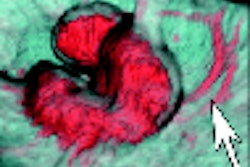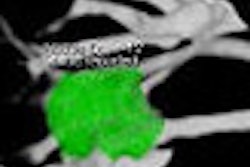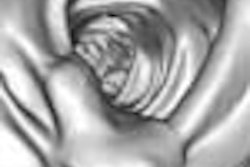Emphysema can alter the CT appearance of peripheral pulmonary nodules, making it harder to distinguish malignant nodules from benign ones. In a Japanese research study done in patients with and without emphysema, correct diagnosis was possible only in 63% of emphysema patients, compared to 93% of patients with normal lung parenchyma.
A strong correlation was found between the degree of emphysema around the nodule and misdiagnosis. Misdiagnosed nodules had a greater mean percentage of emphysema around them as compared to the nodules diagnosed correctly (p = 0.003). The findings have been published in Radiology (April 2005, Vol. 235:1, pp. 266-273).
The retrospective study included 41 emphysema patients and 40 patients with normal lung parenchyma, who underwent CT at the St. Marianna University School of Medicine between January 2000 and May 2003.
Scanning for 11 patients with emphysema and 13 without emphysema was done using multidetector-row spiral Aquilion or Asteion CT scanner (Toshiba Medical Systems, Tokyo) within one breath-hold at deep inspiration. The rest of the patients were scanned with the single-slice X-Vigor helical CT scanner (Toshiba Medical Systems). The CT images of 2-mm slice thickness were evaluated by two chest radiologists blinded to the final diagnosis.
By evaluating the CT scan, the extent of emphysema in the lung was graded into three categories: emphysema less than 30%, emphysema between 30% and 60%, and emphysema greater than 60%. The degree of emphysema around the nodules was also graded, with 100% indicating the nodule was surrounded by emphysema and 0% indicating the nodule was surrounded by normal lung parenchyma.
Diagnosis of benign and malignant nodules
In the emphysematous lung group, 13 of the 32 nodules diagnosed as malignant were misdiagnosed, and two of the nine nodules diagnosed as benign were misdiagnosed. "The two malignant nodules diagnosed as benign had a well-defined polygonal shape and exhibited no lobulation, spiculation, or air bronchogram," the researchers noted.
In the nonemphysematous lung group, three of the 23 nodules diagnosed as malignant were misdiagnosed. There was no misdiagnosis of benign nodules.
The categorization of the nodules on CT findings was based on the characteristic features for malignant and benign nodules. In cases in which the nodule showed CT features of both malignancy and benignity, it was diagnosed as malignant.
"It is highly probable that a nodule with a lobulated contour and an irregular or spiculated margin is malignant, and also highly probable that an oval or polygonal nodule with smooth, well-defined margins is benign," the researchers wrote.
CT analysis included the maximum size, shape, and margin of the nodule and the presence or absence of ground-glass opacity and internal low attenuation such as air bronchogram or cavitation.
In addition, fractal dimension and circularity were also calculated for both the patients groups. Fractal analysis is a mathematical method used to quantify texture on digital images that provides physical measurements related to the complexity of an object. Circularity is a measure of how circular the nodule is, with 1.0 indicating a perfect circle.
Problems with emphysematous lungs
In patients with emphysematous lungs, there was no significant difference between benign and malignant nodules in terms of well-defined borders, spiculation, internal low-attenuating areas, and ground-glass opacities. Lobulation was seen more in malignant nodules but the difference was not significant (p = 0.11), the researchers stated.
On the other hand, in patients with normal lung parenchyma, the frequency of well-defined borders was significantly greater in benign nodules, and the frequency of lobulation and spiculation was significantly greater in malignant nodules. There was no significant difference in the frequencies of internal low-attenuating areas or ground-glass opacity.
A CT findings score was computed for each nodule by giving one point each for ill-defined borders, lobulation, spiculation, air bronchogram, and ground-glass opacity. Malignant nodules had significantly higher CT findings scores compared to benign nodules in the patient group without emphysema.
Similarly, malignant nodules showed significantly higher fractal dimensions compared to benign nodules in the patient group without emphysema. Also, the circularity of malignant nodules was significantly less compared to benign nodules in this group.
However, in the emphysema patient group, there were no significant differences between malignant nodules and benign nodules in terms of the CT findings scores, fractal dimensions, or circularity. The benign nodules in this group had higher CT findings scores and fractal dimensions than those in the normal lung parenchyma group.
"In all patients with benign nodules, the mean scores for CT findings and fractal dimensions were significantly greater in patients with emphysema than in those without (p = 0.002 and p < 0.009, respectively), and the mean circularity was significantly less (p < 0.001)," the researchers observed.
For malignant nodules, there was no significant difference in the mean scores for CT findings (p = 0.574), fractal dimension (p = 0.215), and circularity (p = 0.958) between the patients with and without emphysema.
In patients with pre-existing emphysema, benign nodules are more likely to exhibit CT characteristics of malignant nodules, such as spiculation, the group stated.
"Malignant and benign nodules associated with emphysema exhibited considerably more overlap in CT features than did nodules in nonemphysematous lungs," they concluded. "CT findings cannot be used to reliably discriminate between malignant and benign nodules associated with severe emphysema."
By N. Shivapriya
AuntMinnie.com contributing writer
May 4, 2005
Related Reading
More PET/CT lung masses seen with hardware-based fusion, April 26, 2005
CT, PET staging may negate need for mediastinoscopy in lung cancer, April 11, 2005
FDG-PET/CT tops other technologies for lymphoma staging, March 23, 2005
CT screening detects early lung cancers, but mortality benefits unclear, March 17, 2005
CAD substantially improves MDCT's sensitivity in detecting lung nodules, January 12, 2005
Copyright © 2005 AuntMinnie.com



















